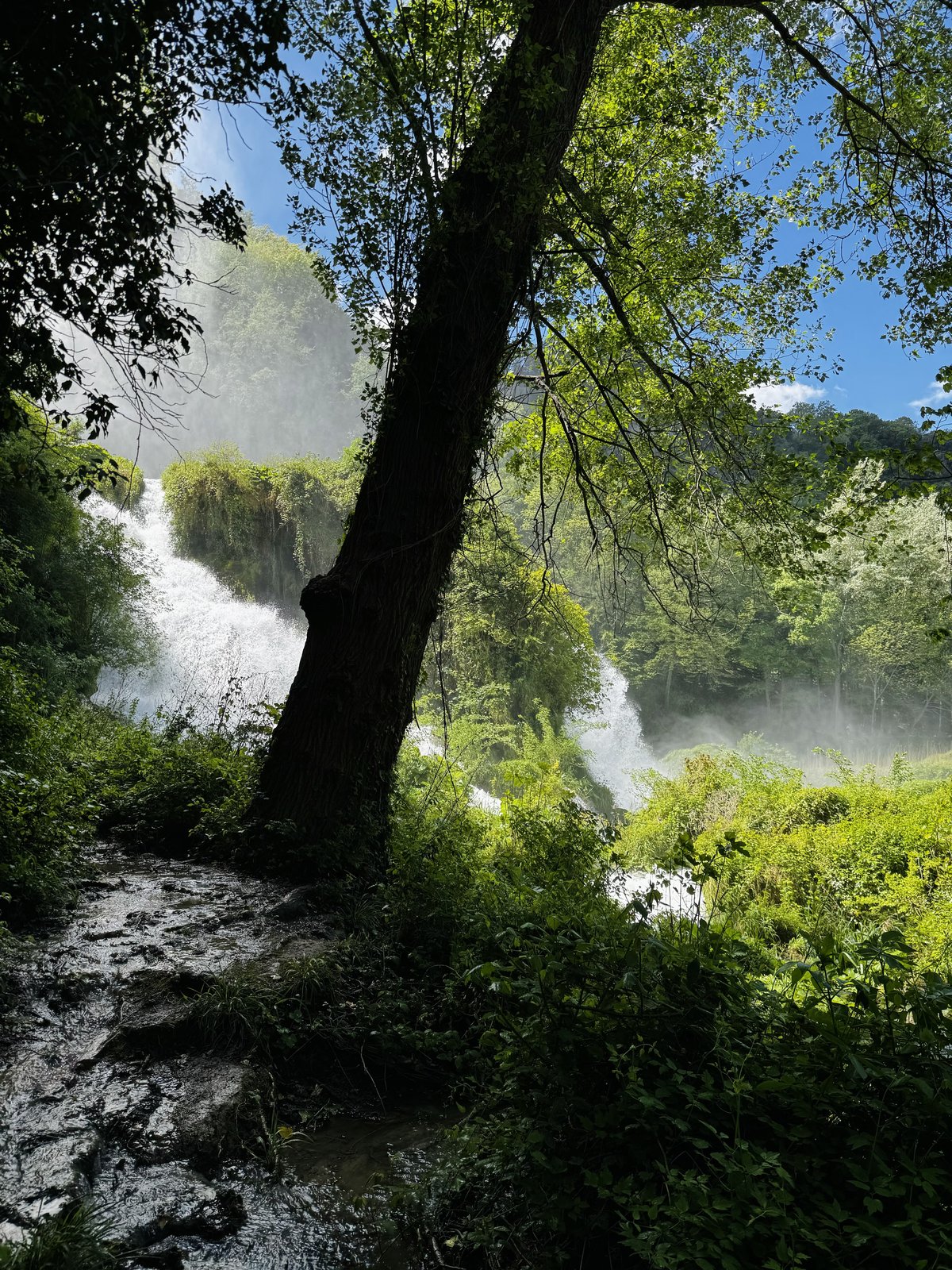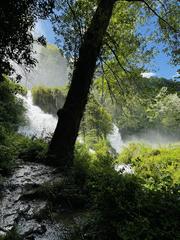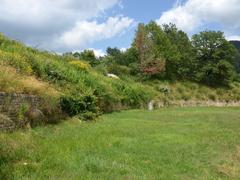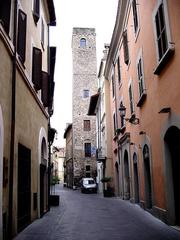
Cascata delle Marmore Visiting Hours, Tickets, and Travel Guide
Date: 14/06/2025
Introduction to Cascata delle Marmore
Nestled in the heart of Umbria near Terni, Cascata delle Marmore is one of Italy’s most spectacular natural landmarks and the tallest man-made waterfall in Europe, plunging a dramatic 165 meters. Its origins stretch back to 271 BCE, when Roman consul Manius Curius Dentatus created the “Cavo Curiano” to drain the malarial marshlands of the Rieti Valley, radically transforming the region’s environment and public health. This ancient feat of engineering set the stage for a unique blend of nature and human ingenuity that has continued to evolve across the centuries (Italia.it; Wikipedia).
Over time, the falls were repeatedly modified—most notably in the Renaissance by Antonio da Sangallo the Younger and in the 18th century by Andrea Vici, commissioned by Pope Pius VI. These interventions not only solved recurring issues like flooding but also gave the falls their iconic three-tiered appearance, which has inspired artists and writers from Lord Byron to Goethe (The Glanz; Euromanticism).
Today, Cascata delle Marmore is both a cultural monument and a vital source of renewable hydroelectric power, managed to balance ecological preservation, tourism, and industry. Its international recognition as a “World Heritage Irrigation Structure” and candidacy for UNESCO World Heritage status underscore its significance as a symbol of sustainable resource use and environmental stewardship (Terni Tomorrow; Umbriatourism).
Visitors can experience a network of scenic trails, panoramic viewpoints, and interactive museums such as the HYDRA Multimedia Museum. Scheduled water releases showcase the full spectacle of the falls, and nearby historic sites in Terni offer further cultural exploration (Cascata delle Marmore official site; Vacanze con Bimbi).
Historical Overview
Roman Origins and Ancient Engineering (3rd Century BCE)
Cascata delle Marmore began as an ambitious Roman engineering project designed to drain the marshlands of the Rieti Valley. By diverting the Velino River over a limestone cliff, the Romans not only improved public health and agriculture but also created the tallest man-made waterfall in Europe (Italia.it; Museo della Cascata).
Medieval and Renaissance Modifications
Through the Middle Ages, ongoing disputes over flooding led to several attempts to improve water flow. The Renaissance saw architect Antonio da Sangallo the Younger commissioned to construct new channels and sluices, further integrating human design with the natural landscape (The Glanz; Umbria Tourism).
Papal Interventions and the Modern Cascade
The greatest transformation came in 1787, when Andrea Vici, under Pope Pius VI, created the three-tiered cascade and modernized water regulation systems. This resolved flooding and established the falls’ current dramatic structure (The Glanz; Euromanticism).
Romantic and Industrial Eras
The falls became a celebrated destination for artists and writers during the Romantic era, immortalized by Lord Byron and others. In the 19th and 20th centuries, the area industrialized, and the waterfall’s power was harnessed for hydroelectricity, supporting Terni’s transformation into a major industrial hub (Museo della Cascata).
Contemporary Significance
Today, the falls are managed both as a major tourist attraction and a source of renewable energy, with scheduled water releases balancing ecological, recreational, and industrial needs. The site is a protected part of Parco della Cascata, preserving biodiversity and offering educational experiences (Italia.it; Umbria Tourism).
Visiting Cascata delle Marmore: Practical Information
Visiting Hours and Water Release Schedule
Cascata delle Marmore is open year-round, with hours varying by season:
- Winter: Generally 9:00 AM – 6:00 PM
- Summer: Extended to 7:00 PM or later (sometimes until 10:30 PM for illuminated night events)
The full force of the falls is visible only during scheduled water releases. These typically occur multiple times per day in spring and summer and less frequently in autumn and winter. Always check the official timetable before your visit.
Tickets and Entry
Tickets range from €5–€10 for adults, with discounts for children, seniors, and groups. Purchase online or at the park entrance; advance booking is recommended, especially in peak season (Vacanze con Bimbi).
Accessibility and Facilities
There are two main entrances: Upper Belvedere and Lower Belvedere. Both offer parking and visitor amenities, with partially accessible paths and viewpoints for those with reduced mobility. Facilities include restrooms, a café, and informative signage. Some trails have stairs and uneven terrain, so wear sturdy shoes.
Guided Tours and Events
Guided tours (available in multiple languages) enrich the experience with historical and ecological insights. Special events, including night illuminations and educational workshops, are held throughout the year. Check the events calendar.
Trails and Activities
The park features six marked trails:
- Trail 1: Connects upper and lower entrances, offering close-up waterfall views.
- Trail 2: Leads to the Lovers’ Balcony, a romantic viewpoint behind the main cascade.
- Trail 3: Offers panoramic vistas of the lower falls and valley.
Other trails explore caves, grottos, and tranquil forested areas. Adventure activities like rafting, kayaking, and canyoning are available, as well as educational walks and birdwatching (This Way to Italy; Summer in Italy).
Terni and Nearby Attractions
Extend your visit with Terni’s historical sites:
- Roman Amphitheater: Ancient ruins reflecting Terni’s Roman heritage.
- Cathedral of San Valentino (Duomo di Terni): Medieval architecture and religious art.
- Palazzo Spada: Historic palace with exhibitions.
The Valnerina valley and its monastic sites are also nearby, offering hiking and cultural experiences (Vacanze con Bimbi).
Sustainable Tourism and Conservation
Cascata delle Marmore is a model of sustainable water management and conservation:
- Hydroelectric Power: The Galleto plant produces renewable energy, balancing ecological and industrial needs (Umbriatourism).
- Environmental Protection: The falls are within a protected park, with strict visitor management to protect sensitive habitats.
- Education: The HYDRA Multimedia Museum and environmental workshops promote awareness of water management and sustainability (Water Museums Network).
- Biodiversity: The surrounding park features diverse flora and fauna, with habitat restoration and monitoring in collaboration with environmental groups.
Frequently Asked Questions (FAQ)
Q: What are the visiting hours for Cascata delle Marmore?
A: The park usually opens from 9:00 AM to 6:00 PM, with extended hours in summer. Check the official website for seasonal updates.
Q: How do I buy tickets?
A: Purchase tickets online or at the entrance. Advance booking is advised in high season.
Q: Are there accessible paths?
A: Some paths and viewpoints are accessible, but many trails involve stairs and uneven ground.
Q: When is the best time to visit?
A: Plan around scheduled water releases—typically mid-morning to early evening in summer—to see the falls at full force.
Q: What else can I see nearby?
A: Terni’s Roman amphitheater, Cathedral of San Valentino, and the Valnerina valley.
Practical Tips for Your Visit
- Arrive early for the best viewing spots, especially before water releases.
- Wear sturdy, non-slip footwear and bring rain gear.
- Stay on marked trails and respect restricted areas.
- Use public transport or shuttle buses to reduce your environmental impact.
- Participate in educational tours and support local businesses.
Conclusion
Cascata delle Marmore is far more than a stunning waterfall—it’s a living testament to over 2,000 years of history, engineering, artistry, and environmental stewardship. By visiting responsibly and supporting conservation efforts, you play a part in preserving this extraordinary site for future generations.
For the latest information on visiting hours, ticketing, tours, and events, see the official Cascata delle Marmore website. Discover more about Terni’s history, Umbria’s attractions, and sustainable travel by exploring related articles and downloading the Audiala app for interactive guides and real-time updates.



